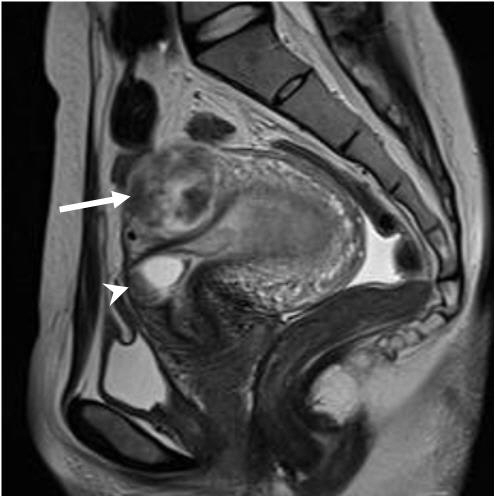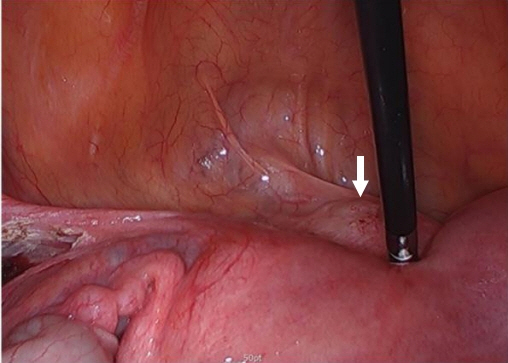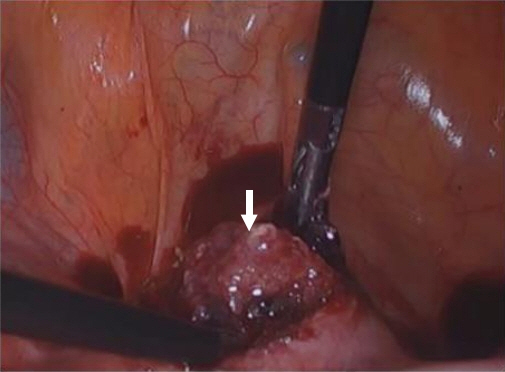J Yeungnam Med Sci.
2023 Apr;40(2):202-206. 10.12701/jyms.2022.00115.
Laparoscopic excision and repair of a cesarean scar pregnancy in a woman with uterine didelphys: a case report
- Affiliations
-
- 1Department of Obstetrics and Gynecology, Keimyung University Dongsan Medical Center, Daegu, Korea
- 2\Department of Obstetrics and Gynecology, Keimyung University School of Medicine, Daegu, Korea
- KMID: 2541948
- DOI: http://doi.org/10.12701/jyms.2022.00115
Abstract
- Cesarean scar pregnancy (CSP) is a rare complication that occurs in less than 1% of ectopic pregnancies, and uterine didelphys is one of the rarest uterine forms. We report a successful laparoscopic excision and repair of CSP in a woman with uterine didelphys and a double vagina. A 34-year-old gravida one, para one woman with a history of low transverse cesarean section presented to our hospital with a suspected CSP. She was confirmed to have uterine didelphys with a double vagina during an infertility examination 7 years earlier. Magnetic resonance imaging showed a 2.5-cm gestational sac-like cystic lesion in the lower segment of the right uterus at the cesarean scar. We decided to perform a laparoscopic approach after informing the patient of the surgical procedure. The lower segment of the previous cesarean site was excised with monopolar diathermy to minimize bleeding. We identified the gestational sac in the lower segment of the right uterus, which was evacuated using spoon forceps. The myometrium and serosa of the uterus were sutured layer-by-layer using synthetic absorbable sutures. No remnant gestational tissue was visible on follow-up ultrasonography one month after the surgery. This laparoscopic approach to CSP in a woman with uterine didelphys is an effective and safe method of treatment. In women with uterine anomalies, it is important to confirm the exact location of the gestational sac by preoperative imaging for successful surgery.
Keyword
Figure
Reference
-
References
1. Seow KM, Huang LW, Lin YH, Lin MY, Tsai YL, Hwang JL. Cesarean scar pregnancy: issues in management. Ultrasound Obstet Gynecol. 2004; 23:247–53.2. Moschos E, Wells CE, Twickler DM. Biometric sonographic findings of abnormally adherent trophoblastic implantations on cesarean delivery scars. J Ultrasound Med. 2014; 33:475–81.3. Timor-Tritsch IE, Monteagudo A, Santos R, Tsymbal T, Pineda G, Arslan AA. The diagnosis, treatment, and follow-up of cesarean scar pregnancy. Am J Obstet Gynecol. 2012; 207:44.4. Kirk E. Ultrasound in the diagnosis of ectopic pregnancy. Clin Obstet Gynecol. 2012; 55:395–401.5. Jurkovic D, Knez J, Appiah A, Farahani L, Mavrelos D, Ross JA. Surgical treatment of Cesarean scar ectopic pregnancy: efficacy and safety of ultrasound-guided suction curettage. Ultrasound Obstet Gynecol. 2016; 47:511–7.6. Rezai S, Bisram P, Lora Alcantara I, Upadhyay R, Lara C, Elmadjian M. Didelphys uterus: a case report and review of the literature. Case Rep Obstet Gynecol. 2015; 2015:865821.7. Riaz RM, Williams TR, Craig BM, Myers DT. Cesarean scar ectopic pregnancy: imaging features, current treatment options, and clinical outcomes. Abdom Imaging. 2015; 40:2589–99.8. Bodur S, Özdamar Ö, Kılıç S, Gün I. The efficacy of the systemic methotrexate treatment in caesarean scar ectopic pregnancy: a quantitative review of English literature. J Obstet Gynaecol. 2015; 35:290–6.9. Peng P, Gui T, Liu X, Chen W, Liu Z. Comparative efficacy and safety of local and systemic methotrexate injection in cesarean scar pregnancy. Ther Clin Risk Manag. 2015; 11:137–42.10. Glenn TL, Bembry J, Findley AD, Yaklic JL, Bhagavath B, Gagneux P, et al. Cesarean scar ectopic pregnancy: current management strategies. Obstet Gynecol Surv. 2018; 73:293–302.11. Tulandi T, Cohen A. Emerging manifestations of cesarean scar defect in reproductive-aged women. J Minim Invasive Gynecol. 2016; 23:893–902.12. Zhai JF, Xu M, Zhang B, Gao JW, Chen N. Treatments of caesarean scar pregnancy and the corresponding results in ten years. Eur Rev Med Pharmacol Sci. 2015; 19:2523–7.13. Wang YL, Su TH, Chen HS. Operative laparoscopy for unruptured ectopic pregnancy in a caesarean scar. BJOG. 2006; 113:1035–8.14. Wang L, Sun L, Wang L, Chen H, Ouyang X, Qiu H. Laparoscopic temporary bilateral uterine artery occlusion with silicone tubing to prevent hemorrhage during vacuum aspiration of cesarean scar pregnancies. J Obstet Gynaecol Res. 2015; 41:1762–8.15. Fuchs N, Manoucheri E, Verbaan M, Einarsson JI. Laparoscopic management of extrauterine pregnancy in caesarean section scar: description of a surgical technique and review of the literature. BJOG. 2015; 122:137–40.16. Vercellino G, Erdemoglu E, Joe A, Hopfenmueller W, Holthaus B, Köhler C, et al. Laparoscopic temporary clipping of uterine artery during laparoscopic myomectomy. Arch Gynecol Obstet. 2012; 286:1181–6.17. Fletcher H, Frederick J, Hardie M, Simeon D. A randomized comparison of vasopressin and tourniquet as hemostatic agents during myomectomy. Obstet Gynecol. 1996; 87:1014–8.18. Chen YJ, Wang PH, Yuan CC, Yen YK, Yang MJ, Ng HT, et al. Pregnancy following treatment of symptomatic myomas with laparoscopic bipolar coagulation of uterine vessels. Hum Reprod. 2003; 18:1077–81.19. Holub Z, Mara M, Kuzel D, Jabor A, Maskova J, Eim J. Pregnancy outcomes after uterine artery occlusion: prospective multicentric study. Fertil Steril. 2008; 90:1886–91.
- Full Text Links
- Actions
-
Cited
- CITED
-
- Close
- Share
- Similar articles
-
- Successful management of cesarean scar pregnancy at 13 weeks of gestation by uterine artery embolization: A case report
- A case of ectopic pregnancy in the previous Cesarean section scar treated by laparoscopic surgery
- Two pregnancy cases of uterine scar dehiscence after laparoscopic myomectomy
- A case of cesarean scar ectopic pregnancy
- A Case of Ectopic Pregnancy within a Previous Cesarean Scar





